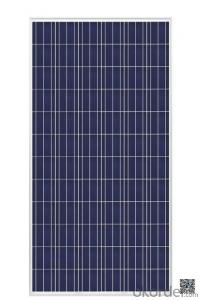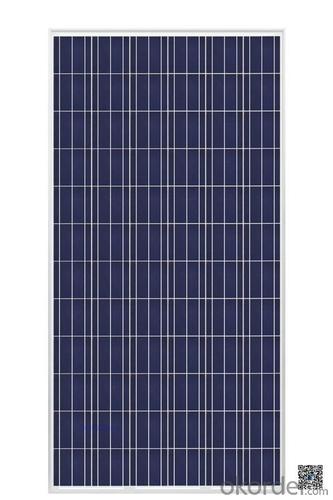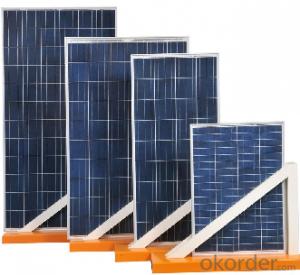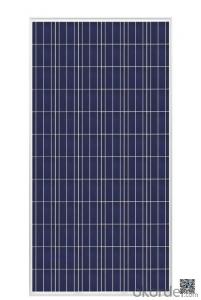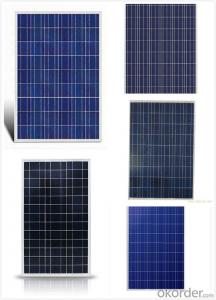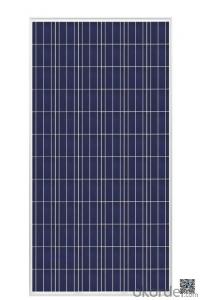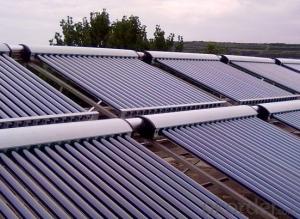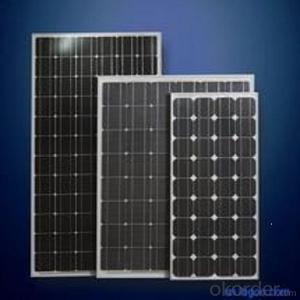Solar Panels for Heater - Solar Panel Poly in China, Solar Module Panel for Low Price
- Loading Port:
- Shanghai
- Payment Terms:
- TT OR LC
- Min Order Qty:
- 2500 watt
- Supply Capability:
- 26000 watt/month
OKorder Service Pledge
OKorder Financial Service
You Might Also Like
Specification
We now provide
• Monocrystalline Solar Panel
• Polycrystalline Solar Panel( multicrystalline silicon Solar Panel)
Features of our products:
Structure of Polycrystalline Silicon Solar Panel
Solar modules, which are widely used in ground mounted utility-scale PV plants, large-scale and small civil and commercial power generating system such as BIPV combined to the grid, roof-mounted PV power system, rural electrification, communications, emergency auxiliary power.
Solar PV module is comprised of some solar cells which are connected in serial with high efficiency and enhanced reliability.
Main Features of Polycrystalline Silicon Solar Panel
High wind-pressure and snow load, and easy installation
Water resistant junction box
Design to meet unique demand of customer
25 year poweroutput warranty
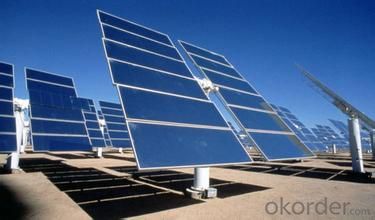
Polycrystalline Silicon Solar Modules 48Cell-195W Specification
ELECTRICAL PERFORMANCE | |||
Power output | P max | W | 195 |
Power output tolerances | ΔP max | W | 0/+5 |
Module effi ciency | η m | % | 14.7 |
Voltage at Pmax | V mpp | V | 23.7 |
Current at Pmax | I mpp | A | 8.03 |
Open-circuit voltage | V oc | V | 30.1 |
Short-circuit current | I sc | A | 8.65 |
Product Description:
This installation Manual contains essential information for the electrical and mechanical installation that your must know before installing CUSTOMER PV modules. This also contains safety information you need to be familiar with .All the information described in this manual are the intellectual property of CNBM and based on the technologies and experiences that have been acquired and accumulated in the long history of CUSTOMER. This document does not constitute a warranty, expressed or implied.
CUSTOMER does not assume responsibility and expressly disclaims liability for loss, damage, or expense arising out of in anyway connected with installation, operation, use or maintenance of the PV modules. No responsibility is assumed by CUSTOMER for any infringement of patents or other rights of third parties that may result from use of PV module.
CUSTOMER reserves the right to make changes to the product, specifications or installation manual without prior notice.
Solar panel working process
In addition to being the ultimate source of all life on earth, the sun is an infinitely renewable, completely pollution-free source of electricity. Instead of burning fossil fuels dug up from the ground in a big power plant – a very 19th century, industrial age approach, when you think about it – solar panels convert sunlight directly into electricity, with no harmful emissions.
The basic unit of a solar panel is a solar cell, which usually consists of one or two layers of silicon-based semiconductor wafers. When struck by the photons in sunlight, the solar cell generates an electrical charge due to the "photovoltaic effect" – which is a pretty good name, since it produces voltage from photons. The flow of these electrons moves in a steady electrical current from one side of the cell to the other.
Dozens of these PV cells are packaged together into solar modules, which in turn are packaged into solar panels that are mounted on a rooftop and arranged to maximize their hours of exposure to direct sunlight. Because the electricity generated by all those solar cells is direct current (DC), it is then sent to an inverter that transforms the power into the same alternating current (AC) used by the appliances in your home and the local utility electricity distribution grid. Increasingly, these inverters are getting "smart," providing data monitoring for solar installation performance and other grid integration services.
- Q: i am trying to figure out how many solar panels can be placed on one acre of land and how much they cost to install
- HOW MANY PANELS FIT IN THE ACRE FIELD? acre = 43560ft? First of all you can not fill the whole acre field with solar panels. There must be space between them so you can walk amongst them and so they don't shade each other. So let's say you can maximally cover 50% of the area. 43560ft?/2= 2780ft? a medium efficient, medium priced polycrystalline solar panel of 200w covers 6ft?. So how many can we fit in your field: 2780ft?/6ft?= 36pcs of 200W solar panels can fit on the field 36pcs*200w= 272200W =272kW of total power harvesting capacity per full sunny hour. HOW MUCH WILL THE PANELS COST? Since you will build such a large solar farm you will want to get the cheapest panels possible. the price per watt on solar panels today is as low as $,5. that will mount up to: 272200W in total *$,5 cost per watt = $408300 for all the solar panels HOW MUCH WILL THE EVERYTHING COST? The whole shebang will be much more expensive since you are going to need inverters, wiring, fuse boxes, handy men to install it all and so on. A 5kW total solar system costs about $0000 if bought from a solar company. that would mean $0 000 * 272200W/5000W= $544 400 for the whole shebang But I strongly believe since you are buying such large quantities you will be able to get better deals then the rest of us mortals. And then you will have a power plant making you free electricity for the next 25- 40 years to come. And you don't necessarily need to set it up in a particularly sunny place for it to be cost effective. Just look at this gorgeous solar Farm from France
- Q: How do solar panels affect home resale value?
- Solar panels can positively impact home resale value by providing potential buyers with energy savings and a reduced carbon footprint. Studies have shown that homes equipped with solar panels tend to sell at a higher price compared to similar homes without them. Additionally, solar panels often increase a home's appeal and marketability, making it more attractive to environmentally-conscious buyers.
- Q: How do solar panels impact the aesthetics of a building?
- Solar panels can impact the aesthetics of a building in both positive and negative ways. On one hand, when designed and installed properly, solar panels can enhance the overall appearance of a building by giving it a modern and eco-friendly look. Additionally, the sleek and reflective surface of solar panels can add a visually appealing element to the design. On the other hand, some people may find the presence of solar panels on a building to be visually unappealing, especially if they disrupt the architectural harmony or contrast with the surrounding environment. Ultimately, the impact of solar panels on a building's aesthetics is subjective and depends on individual preferences and the integration of the panels into the overall design.
- Q: What is the difference between solar panels and light panels?
- The highest conversion efficiency in the laboratory is 24.7%, and the efficiency of the scale is 16%. Polysilicon conversion rate of 14% -15%. Amorphous silicon conversion rate of 12%. Silicon film conversion rate of 9%. Silicon solar cell is the main raw material of silicon, silicon is an extremely rich element of the earth, almost everywhere there are silicon, can be said to be inexhaustible, with silicon to create solar cells, raw materials can be described as no shortage.
- Q: I am told there are night vision goggles to see at night due to invisible light still hitting earth. I am also told that there are other beams, x-rays etc hitting earth.Why couldn't they invent a solar panel with dual power in the day?It could harness both visible and invisible light, and at night be single?Anyone know why they can't make an invisible light solar panel?Is this possible?What happens if future cars have night vision windshields instead of lights?
- Build okorder /
- Q: im trying to run my house with with solar panels, is it possible? if so please let me know how....i have a 6000 w inverter
- It is not feasible to do everything with solar panels. However, if you overproduce during the day and sell the excess to the power company, you might be able to [pay for what you have to buy from them. Another thing you can do is use renewable energy in other forms, with windmills, hydraulic rams, and trombe walls.
- Q: Was looking at 0w solar panel kit. Does this mean, all I can use is something like a 0W CFL light bulb and nothing else?
- Graham is on the right track. However, you need to factor in a 80% DC to AC conversion loss. But yes a 0W CFL is about the size of it... Harbor Freight sells a system consisting of panels, battery, inverter, and TWO CFL's for $250. (You can power 2 CFL's off the grid for a very long time for $250)
- Q: How do solar panels affect the overall sustainability of a building?
- Solar panels positively affect the overall sustainability of a building by reducing reliance on non-renewable energy sources and decreasing carbon emissions. They generate clean and renewable energy from the sun, reducing the building's environmental footprint and contributing to a greener future. Additionally, solar panels can lower energy costs, increase energy efficiency, and provide energy independence, making the building more resilient and sustainable in the long run.
- Q: Can solar panels work at night?
- No, solar panels cannot generate electricity at night as they rely on sunlight to produce power.
- Q: okay so my teacher is trying to install a solar panel but we have a problem we don't know where to ground it because it will be a movil house. guys do you have any ideas?
- Typically you mount it with the frame as a ground and you ground the frame with a wire or cable tied into the ground when the mobile home is parked.
Send your message to us
Solar Panels for Heater - Solar Panel Poly in China, Solar Module Panel for Low Price
- Loading Port:
- Shanghai
- Payment Terms:
- TT OR LC
- Min Order Qty:
- 2500 watt
- Supply Capability:
- 26000 watt/month
OKorder Service Pledge
OKorder Financial Service
Similar products
Hot products
Hot Searches
Related keywords
